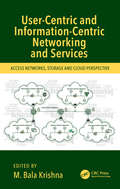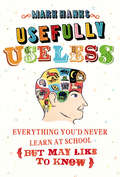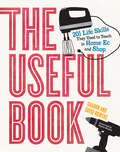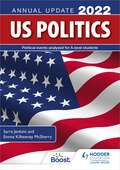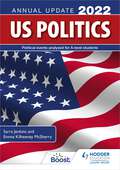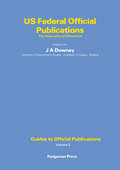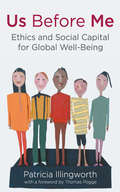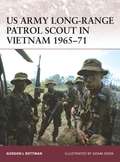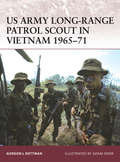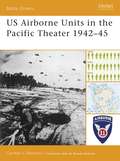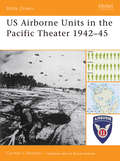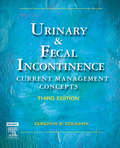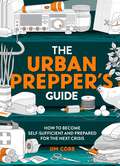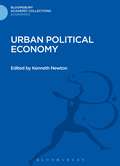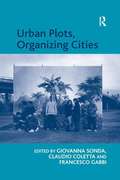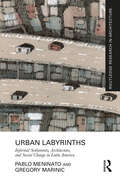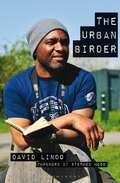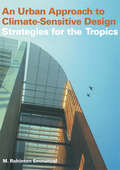- Table View
- List View
User-Centric and Information-Centric Networking and Services: Access Networks, Storage and Cloud Perspective
by M. Bala KrishnaUser-Centric Networks (UCN) and Information-Centric Networks (ICN) are new communication paradigms to increase the efficiency of content delivery and also content availability. In this new concept, the network infrastructure actively contributes to content caching and distribution. This book presents the basic concepts of UCN and ICN, describes the main architecture proposals for these networks, and discusses the main challenges to their development. The book also looks at the current challenges for this concept, including naming, routing and caching on the network-core elements, several aspects of content security, user privacy, and practical issues in implementing UCN and ICN.
User-Centric and Information-Centric Networking and Services: Access Networks, Storage and Cloud Perspective
by M. Bala KrishnaUser-Centric Networks (UCN) and Information-Centric Networks (ICN) are new communication paradigms to increase the efficiency of content delivery and also content availability. In this new concept, the network infrastructure actively contributes to content caching and distribution. This book presents the basic concepts of UCN and ICN, describes the main architecture proposals for these networks, and discusses the main challenges to their development. The book also looks at the current challenges for this concept, including naming, routing and caching on the network-core elements, several aspects of content security, user privacy, and practical issues in implementing UCN and ICN.
Usefully Useless: Everything you'd Never Learn at School (But May Like to Know)
by Mark HanksUsefully Useless is a gloriously diverse volume dedicated to the most engrossing trivia in the world. Guaranteed to excite the curiosity and amuse, its pages are filled with the sort of remarkable information you would never learn, but will be overjoyed to discover. Each fact is irresistibly fun and fascinating - the essence of anecdote and dinner-party conversation that is essential in the adult world - and, above all, usefully useless. Guaranteed to improve your mind, Usefully Useless contains a wealth of miscellany on a vast range of topics, including Literature, Geography, Food, Science, the Natural World, Sport and Politics - from the export of frogs' legs to the longest Monopoly game completed in the bath. Usefully Useless provides answers to such eternal questions as:What was Margaret Thatcher's favourite sitcom?Which British league football team's name has no letters that one could colour in with a pen?How many calories do you consume when you lick a stamp?What was the original colour of Coca-Cola?Which key do toilets flush in?Find out these answers and many, many more in Usefully Useless, the essential guide to the facts you never thought you'd need to know.
The Useful Book: 201 Life Skills They Used to Teach in Home Ec and Shop
by David Bowers Sharon BowersA modern and energetically designed encyclopedia of DIY with everything you need to know to roll up your sleeves and cook it, build it, sew it, clean it, or repair it yourself. In other words, everything you would have learned from your shop and home ec teachers, if you'd had them.The Useful Book features 138 practical projects and how-tos, with step-by-step instructions and illustrations, relevant charts, sidebars, lists, and handy toolboxes. There&’s a kitchen crash course, including the must-haves for a well-stocked pantry; how to boil an egg (and peel it frustration-free); how to grill, steam, sauté, and roast vegetables. There&’s Sewing 101, plus how to fold a fitted sheet, tie a tie, mop a floor, make a bed, and set the table for a formal dinner. Next up: a 21st-century shop class. The tools that everyone should have, and dozens of cool projects that teach fundamental techniques. Practice measuring, cutting, and nailing by building a birdhouse. Make a bookshelf or a riveted metal picture frame. Plus: do-it-yourself plumbing; car repair basics; and home maintenance, from priming and painting to refinishing wood floors.
Use litter bin symbol (UEB Uncontracted)
by RnibThis famous pictogram shows a person throwing litter into a litterbin. It is an international copyright-free logo called the Tidyman. It was designed in the early 1970s and used as part of the Keep Britain Tidy campaign. A new copyright pay-per-use version has been designed as part of the 2010 Love Where You Live campaign. There is a locator dot shown, which will be at the top left of the page when the image is the correct way up. The black and white pictogram is in the middle of the page. On the left of the image is a mesh litterbin and to the right of this is the stylised image of a person dropping paper into the bin. The person is seen from the side and facing to the left with an arm held out to the left. The hand and feet of the person are not shown. The arm and legs end in points.
Use litter bin symbol (UEB Contracted)
by RnibThis famous pictogram shows a person throwing litter into a litterbin. It is an international copyright-free logo called the Tidyman. It was designed in the early 1970s and used as part of the Keep Britain Tidy campaign. A new copyright pay-per-use version has been designed as part of the 2010 Love Where You Live campaign. There is a locator dot shown, which will be at the top left of the page when the image is the correct way up. The black and white pictogram is in the middle of the page. On the left of the image is a mesh litterbin and to the right of this is the stylised image of a person dropping paper into the bin. The person is seen from the side and facing to the left with an arm held out to the left. The hand and feet of the person are not shown. The arm and legs end in points.
Use litter bin symbol (Large Print)
by RnibThis famous pictogram shows a person throwing litter into a litterbin. It is an international copyright-free logo called the Tidyman. It was designed in the early 1970s and used as part of the Keep Britain Tidy campaign. A new copyright pay-per-use version has been designed as part of the 2010 Love Where You Live campaign. There is a locator dot shown, which will be at the top left of the page when the image is the correct way up. The black and white pictogram is in the middle of the page. On the left of the image is a mesh litterbin and to the right of this is the stylised image of a person dropping paper into the bin. The person is seen from the side and facing to the left with an arm held out to the left. The hand and feet of the person are not shown. The arm and legs end in points.
US Politics Annual Update 2022
by Sarra Jenkins Emma Kilheeney McSherryThis US Politics Annual Update will help students:- Review all the relevant developments in US politics from the last year, with examples linked closely to A-level specification points- Develop their confidence with expert analysis they can draw on both throughout their course and in the exams- Enhance their knowledge to build a bank of up-to-date examples linked to the specifications, helping them to develop persuasive arguments for their essays- Learn more about the US government's response to the COVID-19 pandemic, Joe Biden's first year as US President, and how to put them into context- Make connections between the latest developments and the political context of the US, with our focused links between the topic, the context and the exam content- Use our updated exam skills feature to clarify how to use the information they have just learned in their examUS Politics Annual Updates 2022 Chapters1. The growing challenge of federalism2. Representation in the 117th Congress3. President Biden's first year 4. Biden's Cabinet5. Supreme Court: The impact of appointments on its future6. The Supreme Court 2020-21: An exercise in fluidity7. How united are parties in the US?8. Insurrection at Congress: January 6th, 2021
US Politics Annual Update 2022
by Sarra Jenkins Emma Kilheeney McSherryThis US Politics Annual Update will help students:- Review all the relevant developments in US politics from the last year, with examples linked closely to A-level specification points- Develop their confidence with expert analysis they can draw on both throughout their course and in the exams- Enhance their knowledge to build a bank of up-to-date examples linked to the specifications, helping them to develop persuasive arguments for their essays- Learn more about the US government's response to the COVID-19 pandemic, Joe Biden's first year as US President, and how to put them into context- Make connections between the latest developments and the political context of the US, with our focused links between the topic, the context and the exam content- Use our updated exam skills feature to clarify how to use the information they have just learned in their examUS Politics Annual Updates 2022 Chapters1. The growing challenge of federalism2. Representation in the 117th Congress3. President Biden's first year 4. Biden's Cabinet5. Supreme Court: The impact of appointments on its future6. The Supreme Court 2020-21: An exercise in fluidity7. How united are parties in the US?8. Insurrection at Congress: January 6th, 2021
US Federal Official Publications: The International Dimension
by James A. DowneyUS Federal Official Publications: The International Dimension is a bibliographic account of U.S. publications. The title aims to present ways for foreigners to procure federal publications that is relevant to them. The text first covers with the acquisition of materials from Monthly Catalog of United States Government Publications. Next, the selection presents items not listed in the Monthly Catalog of United States Government Publications, particularly government contract reports. The book will be of great use to economists, political scientists, and individuals who have an interest in U.S. government publications.
Us Before Me: Ethics and Social Capital for Global Well-Being
by P. IllingworthPatricia Illingworth's short, powerful and passionate book argues that "social capital" should be an essential ethical concept guiding our actions, and explains how one might go about implementing this idea in a positive way.
US Army Long-Range Patrol Scout in Vietnam 1965-71 (Warrior)
by Adam Hook Gordon L. RottmanThe Vietnamese knew the Long-Range Patrol Scouts as "the men with green faces,†? a reference to the camouflage paint that they used. Operating in patrols of four to six men these men were like ghosts – scouting far behind enemy lines. This book examines the Long-Range Patrol Scout's superior stealth movement techniques, camouflage and concealment, tracking, counter-tracking, observation, and other fieldcraft skills. It also examines the occasions they participated in small-scale direct actions including ambushes and raids. Written by a Special Forces' Vietnam veteran, this book not only depicts the remarkable lives of these scouts when on campaign, but also details the training and conditioning that it took to become one of these shadow warriors.
US Army Long-Range Patrol Scout in Vietnam 1965-71 (Warrior #132)
by Gordon L. Rottman Mr Adam HookThe Vietnamese knew the Long-Range Patrol Scouts as "the men with green faces,†? a reference to the camouflage paint that they used. Operating in patrols of four to six men these men were like ghosts – scouting far behind enemy lines. This book examines the Long-Range Patrol Scout's superior stealth movement techniques, camouflage and concealment, tracking, counter-tracking, observation, and other fieldcraft skills. It also examines the occasions they participated in small-scale direct actions including ambushes and raids. Written by a Special Forces' Vietnam veteran, this book not only depicts the remarkable lives of these scouts when on campaign, but also details the training and conditioning that it took to become one of these shadow warriors.
US Airborne Units in the Pacific Theater 1942–45 (Battle Orders)
by Gordon L. RottmanThis book examines the wide variety of airborne units that served in the Pacific Theater. Among the units covered are the 12,000-strong 11th Airborne Division; the elite 1st Special Service Force; the 503rd Parachute Infantry Regiment (Separate); and the 1st Marine Parachute Regiment. The nature of the enemy and the terrain in the PTO, and long distances that had to be covered, provided significant and diverse challenges to both Army and Marine Corps parachute units. Internal organization, weapons and equipment, command and control, training, combat missions, and combat operations including the 11th Division's fighting in the Philippines, and the 503rd PIR's legendary jump onto Corregidor and recapture of the island are all covered.
US Airborne Units in the Pacific Theater 1942–45 (Battle Orders #26)
by Gordon L. RottmanThis book examines the wide variety of airborne units that served in the Pacific Theater. Among the units covered are the 12,000-strong 11th Airborne Division; the elite 1st Special Service Force; the 503rd Parachute Infantry Regiment (Separate); and the 1st Marine Parachute Regiment. The nature of the enemy and the terrain in the PTO, and long distances that had to be covered, provided significant and diverse challenges to both Army and Marine Corps parachute units. Internal organization, weapons and equipment, command and control, training, combat missions, and combat operations including the 11th Division's fighting in the Philippines, and the 503rd PIR's legendary jump onto Corregidor and recapture of the island are all covered.
Urinary & Fecal Incontinence - E-Book: Current Management Concepts
by Dorothy B. DoughtyCompletely updated to reflect current practice, the 3rd edition of this comprehensive resource provides a multi-disciplinary, in-depth review of the physiology of continence, the pathologic mechanisms producing incontinence, and current treatment options for the various types of incontinence. Assessment, behavioral therapies, and multidisciplinary care are emphasized as key elements in the treatment and management of incontinence. In addition to the life-span content discussed throughout the book, an entire chapter is devoted to bowel and bladder management in children.Authored and contributed by leaders in the Wound, Ostomy and Continence Nurses Society (WOCN). Provides an in-depth review of the physiology of continence, the pathologic mechanisms producing incontinence, and current treatment options to facilitate optimal assessment and care. Features detailed assessment guidelines to help clinicians accurately identify causative and contributing factors, and implement of a comprehensive management plan. Discusses urinary incontinence and fecal incontinence in separate sections to address the special considerations for each in an organized, focused, easy-to-use format. Features individual, complete chapters for each of the following types of incontinence: stress, functional, reflex (neurogenic bladder), and overactive bladder (urge incontinence). Devotes separate chapters to Pathology & Management of Postprostatectomy Incontinence and Bowel and Bladder Management in Children to ensure comprehensive coverage of these topics. Offers life-span content to help clinicians provide appropriate care for patients in every stage of life. Includes self-assessment questions with answers and rationales for review and self-testing. Integrates multidisciplinary care throughout to highlight its importance in successful treatment.Features a new chapter on Pathology & Management of Postprostatectomy Incontinence that provides detailed information on this increasingly important aspect of incontinence. Includes content on the impact of spinal cord injury on bladder and bowel function.
The Urban Prepper's Guide: How To Become Self-Sufficient And Prepared For The Next Crisis
by Jim CobbPrepare for future worst-case scenarios while learning to be self-sufficient every day. It's become clear that even in the twenty-first century our comfortable lives can be disrupted at a moment's notice by events far beyond our control. Whether these are global disasters like a pandemic or a continent-spanning war, or local catastrophes like wildfires, floods, power outages or even food-and-essentials supply issues, you need to know how to respond to a wide variety of emergencies.Written by Jim Cobb, an authority on prepping and disaster readiness, The Urban Prepper's Guide will introduce you to techniques and strategies that can prepare your home and loved ones. These simple measures – designed specifically for urban and suburban dwellers who have tight budgets and limited space – include: • Water – how to safely store and purify water • Food – how to store, preserve, and cook food in an emergency • Shelter – how to shield yourself from the elements without power • Medical – how to be prepared for injuries and illnesses • Security – how to protect your house and valuables • Communication – how to stay informed in an emergency • Every Day Carry – how to be ready to handle problems wherever you are • Home Safety – how to protect against fire and other accidents • Financial Preparedness – how to start planning on a tight budget • Soft Skills – how to think clearly and communicate effectively in a crisis • Emergency Evacuation – how to be ready to evacuate at a moment's notice • Mindset – how to develop a survivor's mindset, and all that entails • The First 24 Hours – how to handle everything when the worst happens
Urban Political Economy (Bloomsbury Academic Collections: Economics)
by Kenneth NewtonThe study of urban political economy needs no justification, for cities are the heart (and arguably the soul) of our civilization, and their political and economic conditions are the linchpins of its existence. But how should we study urban political economy?Urban Political Economy deals with different nations – Belgium, Denmark, France, Norway, the UK. and the USA – and with different problems – expenditure patterns, service provision, economic development, fiscal strain, budgetary cuts, and borrowing systems – but they all agree on two fundamental points about the study of their subject matter: first, that the urban economy cannot be understood outside its political context, just as urban politics cannot be understood without its economic background; and second, that the local and the national are knitted together so closely and so tightly that it is necessary to think of them as forming a single system.Urban Political Economy explores the idea of the fusion of factors by demonstrating the extent to which local and national conditions react upon one another to analyze the urban political economy.
Urban Plots, Organizing Cities (PDF)
by Claudio Coletta Giovanna Sonda Francesco GabbiBy focusing on the interplay between material, social and narrative dimensions of the city, this book examines urban complexity, namely the dynamic and entangled nature of urban issues, and puts forward a notion of the city as an urban texture. Taking an innovative interdisciplinary approach, it perceives the way cities are organized as a restless stratification of materials, meanings and uses, and deals with the interrelationships between actors, places, administrative rationalities and artefacts. It argues that urban fabric is 'manufactured' in this interplay between imagery and practices (of all the stake-holders, including planners, city managers and city users). Illustrated by in-depth empirical studies from across Europe and Latin America, the book explores material and symbolic aspects of the urban experience. In particular, the contributors focus on the less visible ways of organizing urban spaces, such as those enacted and embodied by local news, artefacts such as signals, maps, regulations, public acts, artistic performances, sensory experience and collective memories. The book offers an articulated discussion on these various means of spatial organisation, thereby providing insights into situations of conflict and proposing innovative ways forward for enhancing urban sociability.
Urban Plots, Organizing Cities
by Claudio Coletta Giovanna Sonda Francesco GabbiBy focusing on the interplay between material, social and narrative dimensions of the city, this book examines urban complexity, namely the dynamic and entangled nature of urban issues, and puts forward a notion of the city as an urban texture. Taking an innovative interdisciplinary approach, it perceives the way cities are organized as a restless stratification of materials, meanings and uses, and deals with the interrelationships between actors, places, administrative rationalities and artefacts. It argues that urban fabric is 'manufactured' in this interplay between imagery and practices (of all the stake-holders, including planners, city managers and city users). Illustrated by in-depth empirical studies from across Europe and Latin America, the book explores material and symbolic aspects of the urban experience. In particular, the contributors focus on the less visible ways of organizing urban spaces, such as those enacted and embodied by local news, artefacts such as signals, maps, regulations, public acts, artistic performances, sensory experience and collective memories. The book offers an articulated discussion on these various means of spatial organisation, thereby providing insights into situations of conflict and proposing innovative ways forward for enhancing urban sociability.
Urban Labyrinths: Informal Settlements, Architecture, and Social Change in Latin America (Routledge Research in Architecture)
by Pablo Meninato Gregory MarinicUrban Labyrinths: Informal Settlements, Architecture, and Social Change in Latin America examines intervention initiatives in informal settlements in Latin American cities as social, spatial, architectural, and cultural processes. From the mid-20th century to the present, Latin America and other regions in the Global South have experienced a remarkable demographic trend, with millions of people moving from rural areas to cities in search of work, healthcare, and education. Without other options, these migrants have created self-built settlements mostly located on the periphery of large metropolitan areas. While the initial reaction of governments was to eliminate these communities, since the 1990s, several Latin American cities began to advance new urban intervention approaches for improving quality of life. This book examines informal settlement interventions in five Latin American cities: Rio de Janeiro, Medellín, São Paulo, Buenos Aires, and Tijuana. It explores the Favela-Bairro Program in Rio de Janeiro during the 1990s which sought to improve living conditions and infrastructure in favelas. It investigates projects propelled by Social Urbanism in Medellín at the beginning of the 2000s, aimed at revitalizing marginalized areas by creating a public transportation network, constructing civic buildings, and creating public spaces. Furthermore, the book examines the long-term initiatives led by SEHAB in São Paulo, which simultaneously addresses favela upgrading works, water pollution remediation strategies, and environmental stewardship. It discusses current intervention initiatives being developed in informal settlements in Buenos Aires and Tijuana, exploring the urban design strategies that address complex challenges faced by these communities. Taken together, the Latin American architects, planners, landscape architects, researchers, and stakeholders involved in these projects confirm that urbanism, architecture, and landscape design can produce positive urban and social transformations for the most underprivileged.This book will be of interest to students, researchers, and professionals in planning, urbanism, architecture, urban design, landscape architecture, urban geography, public policy, as well as other spatial design disciplines.
Urban Labyrinths: Informal Settlements, Architecture, and Social Change in Latin America (Routledge Research in Architecture)
by Pablo Meninato Gregory MarinicUrban Labyrinths: Informal Settlements, Architecture, and Social Change in Latin America examines intervention initiatives in informal settlements in Latin American cities as social, spatial, architectural, and cultural processes. From the mid-20th century to the present, Latin America and other regions in the Global South have experienced a remarkable demographic trend, with millions of people moving from rural areas to cities in search of work, healthcare, and education. Without other options, these migrants have created self-built settlements mostly located on the periphery of large metropolitan areas. While the initial reaction of governments was to eliminate these communities, since the 1990s, several Latin American cities began to advance new urban intervention approaches for improving quality of life. This book examines informal settlement interventions in five Latin American cities: Rio de Janeiro, Medellín, São Paulo, Buenos Aires, and Tijuana. It explores the Favela-Bairro Program in Rio de Janeiro during the 1990s which sought to improve living conditions and infrastructure in favelas. It investigates projects propelled by Social Urbanism in Medellín at the beginning of the 2000s, aimed at revitalizing marginalized areas by creating a public transportation network, constructing civic buildings, and creating public spaces. Furthermore, the book examines the long-term initiatives led by SEHAB in São Paulo, which simultaneously addresses favela upgrading works, water pollution remediation strategies, and environmental stewardship. It discusses current intervention initiatives being developed in informal settlements in Buenos Aires and Tijuana, exploring the urban design strategies that address complex challenges faced by these communities. Taken together, the Latin American architects, planners, landscape architects, researchers, and stakeholders involved in these projects confirm that urbanism, architecture, and landscape design can produce positive urban and social transformations for the most underprivileged.This book will be of interest to students, researchers, and professionals in planning, urbanism, architecture, urban design, landscape architecture, urban geography, public policy, as well as other spatial design disciplines.
The Urban Birder
by David LindoAnyone can become an Urban Birder. You can do it anywhere and any time, whether you've got the day to spare, on your way to work, during your lunch break or just looking out of a window. Look up and you will see.The book is an inspirational look at the birdlife in our cities, or more accurately, the author's personal journey of discovery involving encounters with racism, air rifle-toting youths, girls, alcohol, music, finding urban wildlife oases and of course, birds.David Lindo's story is entertaining and sometimes controversial, but the one guarantee is that the reader will be left feeling inspired enough to pick up a pair of binoculars and head to the nearest park.
An Urban Approach To Climate Sensitive Design: Strategies for the Tropics
by Rohinton EmmanuelThe need to respond to the rapidly changing city climate is particularly urgent in the tropics where the urban transition is currently at its peak. While the need is clearly felt by the tropical urban dwellers, texts that provide an overview of the problem and indicate possible design solutions are rare. This comprehensive reference will be welcomed by student and practising architects as well as other built envronment professionals engaged with the environmental effects of building in worldwide warm and humid climates.
An Urban Approach To Climate Sensitive Design: Strategies for the Tropics
by Rohinton EmmanuelThe need to respond to the rapidly changing city climate is particularly urgent in the tropics where the urban transition is currently at its peak. While the need is clearly felt by the tropical urban dwellers, texts that provide an overview of the problem and indicate possible design solutions are rare. This comprehensive reference will be welcomed by student and practising architects as well as other built envronment professionals engaged with the environmental effects of building in worldwide warm and humid climates.
